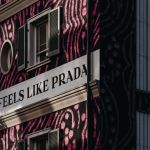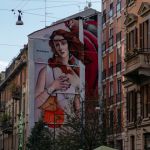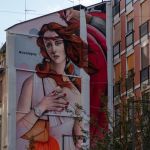
Fashion on the walls of Milan
The cultural relevance of fashion brands in the city also passes through urban surfaces
September 22nd, 2021
Laurent Bentil
Today, with the beginning of fashion week, the streets of the city have been filled with buyers and journalists, models and fashion insiders of all kinds, each of whom colors every corner of Milan with their own outfits. But for those who live in Milan all year round and not only during fashion week, fashion is part of the urban fabric of the city itself: on the scaffolding that covers the buildings of the center appeared a giant print of Justin Bieber in Balenciaga and at the tram stops or along the streets run backlit posters of the new Moncler event or the latest Prada campaign while near the skyscrapers of Porta Nuova stands a titanic photo by Dua Lipa in Versace. Looking up in virtually every point of the city, images of fashion campaigns are everywhere – both in the form of the classic billboard and in that of installation and street art. The most famous advertising space in the city is perhaps the historic Giorgio Armani commercial in Via Broletto, opened in 1984 which soon became a geographical reference point for all the inhabitants of the area. More recent examples of this phenomenon instead are the Gucci Art Wall, which since 2018 dominates Corso Garibaldi and which inaugurated in advance the season of the advertising mural then continued with the Inter mural in Isola, but also the one created by Off-White™ in Columns and the palace covered with the floral fantasy of Prada in Porta Venezia.
The link between the Milanese landscape and fashion advertising does not speak so much of a commercial overcrowding as more of an increasingly strong relationship of symbiosis between the public and private institutions of the city. It remains emblematic, in this regard, the billboard that MSGM placed in Via Orefici with the phrase I thought it was love and instead it was Milan, photographed as much as I can within a few months and even worn by Beppe Sala on Instagram. But they are various city brands such as Prada and Armani, and above all the Camera della Moda, the Triennale and the Salone Internazionale del Mobile whose initiatives fill the city calendar with thematic "weeks" and almost continuous happenings, helping to nourish that synergy that unites together the institutional, private and real public that moves and animates the structures that the first two have created together. This connection between institutions and brands is so deeply rooted that the latter come to finance entire urban redevelopment projects, such as the one that will involve the former Scalo di Porta Romana, financed, among others, by Prada.
But the strength of this bond of civic and commercial-cultural authorities emerges much more through the format of the wall installation, billboard or mural – so much so that over the last year many companies have decorated the city walls collaborating with local artists, forging relationships with administrators of historic buildings and with the municipal authorities: from the Fineco bank, to Alfa Romeo, Samsung and the Scalapay payment service that has decorated with a giant Botticellian Venus the wall opposite to that of the Gucci Art Wall on Corso Garibaldi. Especially murals have become very frequent during and immediately after 2020, as redevelopment projects that are easily manageable and relatively short to carry out, and therefore in perfect line with both the objectives of the public administration, and with the need for visibility of the client brands and local artists, whose name in some cases has become something similar to that of a micro-celebrity. The closing of the symbolic circle took place when condominium administrations and associations of shopkeepers formally requested that one of these murals, The Vision by Cosimo Caiffa in Porta Romana, not be removed and remain part of the city panorama. Perhaps the first case in which citizens ask institutions not to remove advertising content from a wall.

Interviewed by La Repubblica about the murals in Milan, Mauro Ferraresi, professor of Sociology of Communication at IULM explained: «Companies have understood the visual power of street art. A type of liquid communication, which argues less than a traditional commercial but which enters people's visual memory to stay there for a long time». The walls of the city have therefore become the privileged meeting place of institutions, brands and the public, offering citizens an "aesthetic moment", as Ferraresi defines it later in the interview, which underlines the cultural relevance of the brands themselves within the city and, therefore, in the daily life of all its inhabitants.



































































